Growing a flower, how to plant it in open ground
The best way to plant and propagate the Red Sharm peony is to split the root system. Plants aged 4-5 years are optimal for this procedure.
Planting by root cuttings
A root cut is a part of the rhizome of a peony that has an independent root and 1 or more eyes for growth. To apply this planting method, you must first select the planting material. Its preparation is carried out as follows:
- Carefully, without damaging the roots, the rhizome of an adult peony is dug out. It is divided into small pieces, each about 6 cm in size. All pieces must have at least 1 bud and root.
- For a couple of hours, parts of the rhizome are placed in a solution of potassium permanganate, then rolled in crushed charcoal and dried in the fresh air until a small crust forms (this will take 10-12 hours, you can leave it overnight).
After that, the planting material is deepened into the nutrient mixture by about 4 cm. The place in which the cuttings will germinate should be well lit. The substrate must be regularly moistened.
Important! You can germinate root cuttings both at home and in the open field. In any case, shoots appear in the spring. They can be transplanted to a permanent place only in a year.
They can be transplanted to a permanent place only in a year.
Peony root stalk
Location selection
The place should be well lit, protected from gusts of cold winds and drafts. Light shading is acceptable, which protects the flower from the midday hot rays. The soil needs nutritious and well-drained soil. Groundwater should pass no higher than 1 m from the plant.
How to prepare the soil and flower for planting
The planting pit is prepared approximately 1 month before planting. The soil should be well loosened, with the obligatory addition of compost and humus, as well as mineral and complex fertilizers. A couple of hours before the direct planting in the ground, the root system of the cuttings is checked for damage and soaked in a solution of potassium permanganate, the cuts are processed with crushed charcoal.
Planting procedure step by step:
- Drainage and necessary fertilizers are introduced into the prepared planting pit.
- Sand is added to too clayey soil and vice versa.
- Prepared seedlings are placed in holes, sprinkled with earth.
After that, the soil is thoroughly watered and mulched with any natural material.
Planting with seeds (for breeding)
Planting with seeds for hybrid varieties is not applicable. Peonies can grow from seeds, but these will already be plants of a different variety, and not Red Charm.
Diseases and pests
Peonies are resistant to disease. However, improper care very often leads to problems.
Gray rot
This problem arises most often with frequent watering. The first symptoms of the disease are wilting of the bush and the absence of buds. Leaves become dull with yellow spots. Gradually, the shoots of the bush become covered with a gray bloom and die. For treatment, it is necessary to remove the damaged area of the culture and carry out the treatment with Bordeaux liquid.
Aphid
Such a pest can appear at any period of culture development, but most often in mid-spring and summer. Small insects feed on the sap of the crop and lead to the death of leaves and shoots. To remove the pest, you can use a solution of laundry soap or a preparation "Fitoverm" for spraying.

Ants
A common problem with peonies. The ants attack the buds and feed on the sweet syrup.As a result, it leads to the destruction of inflorescences. To remove pests, it is necessary to spray the area where the plants grow with special repellents.
Description of peony Red Magic
Peony Red Magik is a short shrub 85 cm long, it grows up to half a meter wide. The leaves are oblong, large, flat, openwork, dark green. They are quite dense, the bush is densely planted.
The first buds bloom in May. Inflorescences are formed not only at the ends of the shoots, but also on the side. They look like large, voluminous balls, their size does not exceed 15 cm, some specimens can reach 25 cm in diameter. The color of the flowers ranges from scarlet to dark burgundy. The variety belongs to densely doubled, since there are many petals in the buds. They differ in shape and color, creating interesting combinations. Freshly blossomed buds have a scarlet color, as they ripen, they become darker, their color will be thick, wine, ruby.
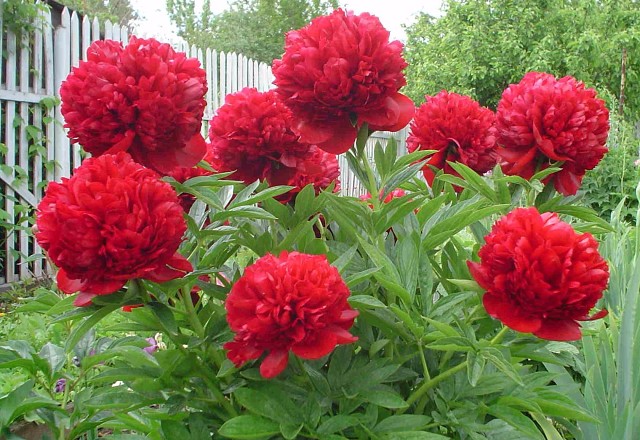
Duration of flowering of each bud - no more than 10 days
The culture is classified as drought-resistant and frost-resistant. Peony Red Magic is able to withstand frosts down to - 40 ᵒС. That is why it is recommended for cultivation throughout Russia.
The best neighbors in a flower arrangement
Peony is undemanding to neighbors, however, it must be borne in mind that the bushes of the culture are large. Therefore, it is necessary to carefully select flowers in a flower bed.
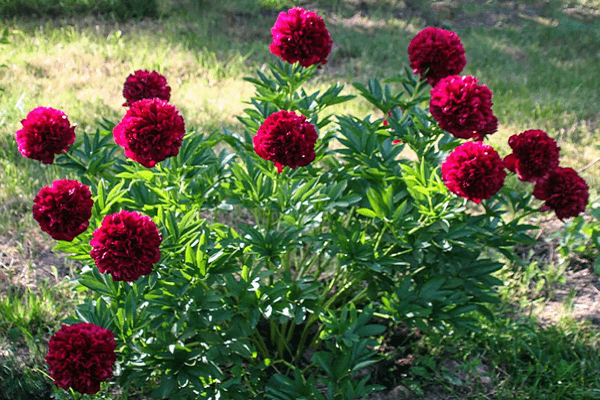
Foliage texture
Peonies will not develop normally next to plants that grow more than the bush itself. Therefore, it is necessary to select crops that have the same leaf texture as peonies, filling the space on the flower garden.
Phlox
Plants can be used with peonies in the composition. They do not have common pests, therefore they do not affect the development of each other. However, it is recommended not to plant at a close distance from each other, leaving room for loosening the soil.
Irises
Unlike peonies, the roots of irises are located in the upper layers of the soil, so these two varieties of crops can be planted on the site. In addition, externally, plants are combined in landscape design.
Sedum
Peony and stonecrop have a similar structure of bush and foliage. Therefore, they can be planted in the same area as the main plants, however, a distance of at least 50 cm must be maintained between the bushes so that the bushes have the necessary space for development.
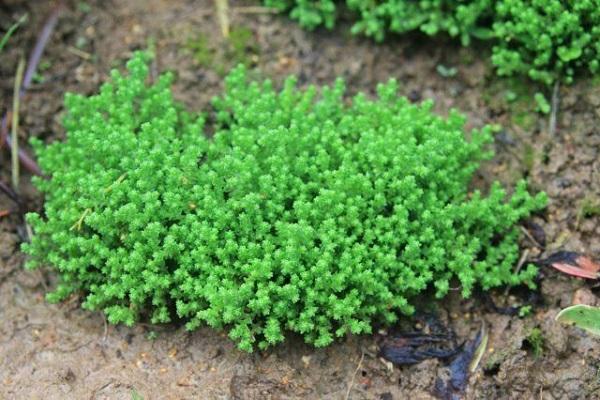
Vertical structure
Peonies can be grown with other tall crop types that exceed shrubs.
Delphinium
The height of the culture is up to 2 meters, it can be grown on the site together with peonies and roses as an additional background for the composition.
Cotton wool
The plant has strong, fleshy stems and can be grown in conjunction with peonies. The height of the bush is on average 150 cm. The culture blooms in the middle of summer. Therefore, it does not affect the development of peonies.
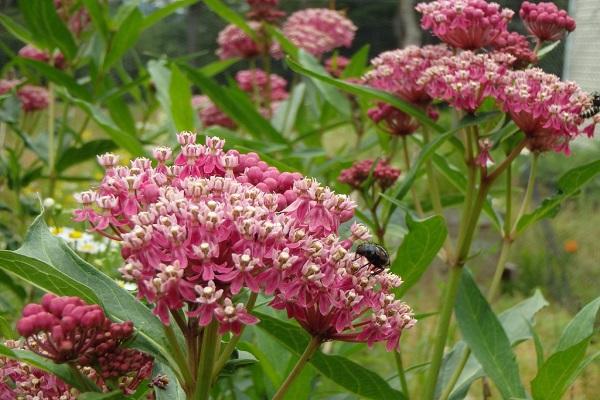
Digitalis
The plant can act as an addition to the appearance of the flower bed, the foxglove blooms at the end of August. Therefore, it does not affect the development of peony buds.
The peony is a decoration of the garden. Peony Red Grace is distinguished not only by its attractive appearance, but also by resistance to diseases. Despite the fact that the plant is odorless, the peony is a popular crop.
Planting, care, design
Modern varieties of peonies are durable. They can grow for many years without any transplants. Both winter frosts and frosts in autumn or spring are very well tolerated by them. You can expect the appearance of characteristic features of a particular variety in the second or third year.
In the second month of autumn, it is recommended to cut off the stems. They retain only 0.02 m above the kidneys.
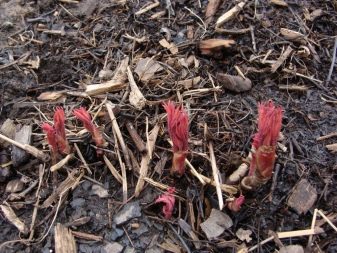
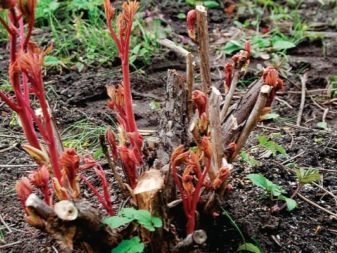
The soil must also be evaluated: if it is heavy and dense, then such a place will not work. To improve the characteristics of the soil, humus or peat is used before planting.
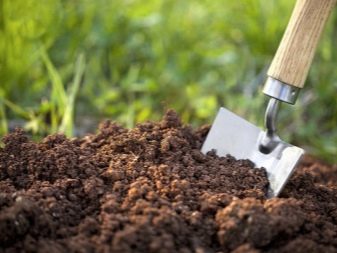

Peonies appreciate high-quality drainage, which means that the holes should be filled with abundant gravel or other suitable material.Peony transplantation is carried out strictly according to special rules:
- dig up plants only when it is warm and dry;
- dig strictly vertically;
- the shovel is removed from the root by 0.2 m;
- they dig in the bushes strictly in a circle;
- do not pull the plant by the leaves;
- pull out the root itself as gently as possible for the peony.
Frost resistance of "Raspberry" peonies is high enough to survive in winter even without auxiliary shelters. But it is still advisable to cut the shrub and cover it before the cold weather begins. Flowering occurs annually. At the same time, the timing of flowering can vary greatly. The earliest peonies will bloom in the last decade of May, and the latest in the second half of June.
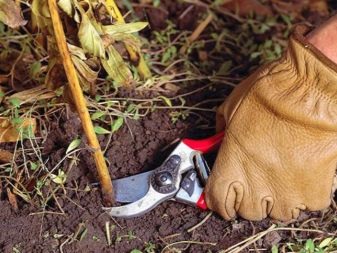
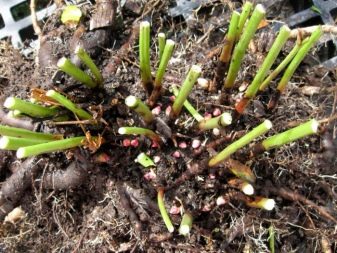
Returning to the selection of the place, it should be mentioned about the optimal acidity (from 6 to 6.6 on the pH scale). Improvement of clayey soil is achieved through peat, sand or humus. Purely sandy soil is improved, on the contrary, with a mixture of peat and humus already with a clay mass. It is necessary to wait for soil subsidence before planting for 6-7 days. Rhizomes should be lightly tamped when planting.
The division and transplantation of peonies is carried out mainly in August or September. A common mistake is replanting the plant in the spring. The specific terms of work depend on the climatic parameters of the area.
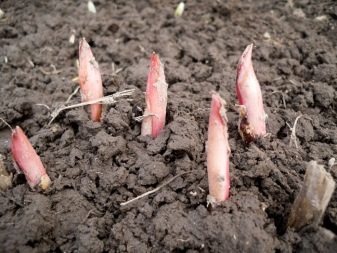
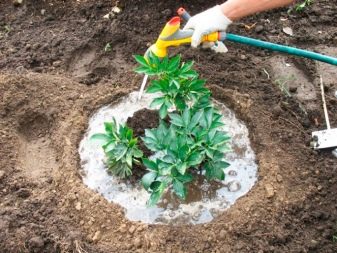
You cannot feed peonies during flowering.
Planting flowers in one line will allow you to delimit the territory into zones. Peonies are also suitable for emphasizing certain objects. They can also be used for the second tier between low and tall crops, in mixborders, next to clematis and roses.
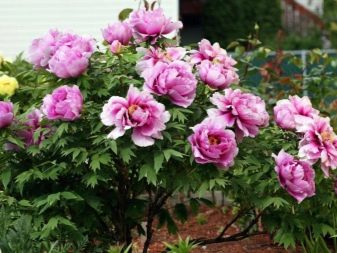
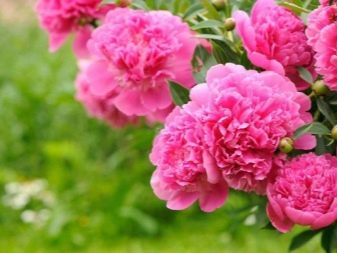
Landing
Planting peonies is similar to a similar procedure for bulbous perennials, but has its own characteristics.
Seat selection
Peony Red Charm is susceptible to fungal infections, therefore it is recommended to grow it in a well-ventilated place. The area should be well lit by the sun, and the soil is preferable with a drainage layer and compost. A flower should not be planted near fences or walls of houses.
Soil preparation
If fertilizers have not been applied to the site, then before planting the Red Charm peony, you should mix the soil with compost or other organic fertilizer. It is recommended to slightly oxidize the soil.
Landing scheme
When planting a peony, keep the distance between the bushes at least 1 meter. It is also taken into account that Red Charm grows well and is able to obscure small flowers or bushes.
It is not difficult to take care of a peony, but in gratitude for the attention, he will surely respond with gorgeous flowering.
Watering
In the dry summer season, peony bushes are watered once every 7 days. Excess moisture leads to the development of fungus and root rot.
Mulching
So that moisture does not evaporate very quickly, and the soil under the bush does not crack, mulching is performed. Mowed hay, dried grass, straw, needles are used as mulch.
Garter
The stems of the Red Charm peony are thick and stable, but still they cannot withstand the weight of the blossoming buds and need a garter. Wooden or metal pegs are installed along the perimeter of the bush, on which twine, nylon rope or wire are pulled in a circle.
Loosening and weeding
To provide the roots with air access, after watering and heavy rainfall, it is necessary to loosen the soil. As soon as they appear, weeds should be removed, weeding the area around the peonies. This will not only give them a well-groomed appearance, but also prevent weeds from taking nutrients and moisture from the ground.
Top dressing
The Red Charm peony should be fed in the third year after planting on the site. Immediately after the snow melts, urea is added (the recommended rates are indicated in the instructions). The second time the flowers are fertilized during budding. The third top dressing is done at the very beginning of flowering, introducing nitrophosphate. 2 weeks after the end of flowering, superphosphate and wood ash must be added under the bushes.
Diseases and pests
Peony Red Charm is capable of being affected not only by viral, but also by fungal diseases. To prevent their appearance, it is necessary to carry out preventive measures in a timely manner. The most common diseases of these colors are:
- rattle;
- mosaic;
- mottling;
- gray rot;
- rust;
- cladosporiosis;
- septoria;
- root rot;
- powdery mildew;
- verticillary wilting.
Some pests can cause irreparable harm to peonies, as a result of which it will not be possible to admire the lush flowering of the bushes. The most common ones are:
We must deal with them immediately.
Preparation for wintering
Peony Red Charm belongs to frost-resistant plants and hibernates in the open field. But even such a flower requires preparation for the cold, which consists primarily in feeding and pruning the bushes. Pruning is carried out after the onset of the first cold weather. It performs a sanitary function and prevents pests from overwintering in stems and leaves.
During autumn feeding, nitrogen fertilizers cannot be used, which can lead to the fact that the flower starts to grow ahead of time. Usually, only phosphorus and potassium are used as fertilizers before wintering. With the onset of the first frost, the trimmed peony bushes are spud, and a layer of mulch with a thickness of at least 15 cm is laid on top.
Growing features
Red Charm peonies need regular care. It includes watering, loosening, pruning, pest control.
The first year after planting is the key for the growth of Red Charm peonies. If autumn or spring, depending on the planting season, are dry and hot, the flower is watered every 2-3 days for a month. In summer, the plant is moistened less often: 1-2 times a week, but abundantly, at least 10 liters of water per bush.
It is important to monitor the condition of the soil before watering: if it is still wet enough, the procedure is postponed the next day.
A day after watering, the soil around the rhizome is loosened. This will provide oxygen access to the root processes.
In hot weather, mulch will help keep moisture in the soil. Sprinkle the earth with a layer of sawdust 2-3 cm.
At the end of May, it is recommended to add top dressing. For these purposes, choose complex mineral fertilizers or ammonium nitrate. They are bred according to the instructions and poured in a circle near the main stem.
Foliar dressing is also recommended. As soon as the shoots begin to grow, the Red Charm flower is sprayed with a urea solution (30 g per 5 l of water). The procedure is repeated twice with an interval of 2 weeks.
Peony Blossom Coral Sunset
This flower is considered early. The first buds bloom in late May - early June. Flowering of this perennial is gradual. An adult bush forms 18-20 buds annually. The first 2-3 days they bloom, the next 3 - bloom, and within 2 days - wither.
The flowers of the Coral peony are huge, up to 24 cm in diameter, with a light aroma. They are semi-double and consist of 5-7 rows of petals. In the center there are bright yellow stamens and light green pistils, which gives a special sophistication. At the beginning, the petals have a rich warm-coral hue, then the pink tone intensifies and at the end they turn light orange.
Important! The difference in the species is that during sunset, its petals fold
A period of activity and rest
This peony continues to bloom for 4 to 6 weeks under favorable conditions. The plant begins to grow shoots and leaves annually in early April. They retain their decorative effect until autumn. And only with the arrival of winter, the aboveground part of this perennial completely dies off. The dormant period lasts from November to the end of March.
The plant requires full care throughout the season. It consists in timely watering and fertilization. Before flowering, this is necessary for the full formation of buds, and after that, for building up recovery buds for the next year.
What to do if it does not bloom, possible reasons
The poor flowering or its complete absence in this hybrid may be due to improper placement of the plant on the site. When planted in the shade, the perennial actively grows leaves and shoots, but at the same time stubbornly refuses to form buds.
It can also be due to a lack of moisture and nutrition. To eliminate the cause, it is recommended to correct the care.
If before the bush bloomed magnificently, and then suddenly stopped, then this sign indicates the need to transplant the plant to a new place.
Planting and leaving
Peonies are recommended to be planted at the end of September. At this time, all biological processes slow down, the plant does not suffer during transplantation, it quickly takes root. You can plant Red Magic peonies in the spring. This must be done immediately after the snow melts. At a later planting, the buds will bloom, the plant will be injured and will not be accepted.
For planting, choose open, sunny areas with good ventilation, but without drafts. Blackout Red Magic peony does not tolerate waterlogging.
To get children, a 4-year-old peony bush with a well-developed root system is chosen. It is carefully removed from the ground with a pitchfork, taking care not to damage the root processes. The rhizome is divided into several parts, they are called delenki.
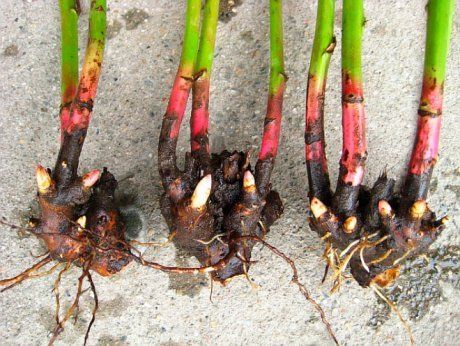
Each new plant should have at least three root shoots and 2-3 buds at the base of the shoot.
Do not make too large units, the weight of each should not exceed 100-150 g.
An hour or two before planting, the rhizome of young plants is soaked in a weak solution of potassium permanganate. Immediately before planting, it is treated with activated carbon powder. This will help block the development of fungal and viral infections.
Landing Algorithm:
- A month before the expected date of planting, a cone-shaped hole is dug.
- A thin layer of gravel is poured onto the bottom of the pit, and garden soil mixed with a glass of wood ash is poured on top.
- The plant is rooted so that the root bud does not fall below the ground level by more than 4 cm.
- The rhizome is covered with loose garden soil, slightly compacted.
After planting, the Red Magic peony is watered abundantly. To retain moisture, the soil is mulched with chips or sawdust.
Features of peonies "Red charm"
We have all the plants in pots! You can plant them all summer!
New entry to the Nursery from spring 2019
Peony photo herbaceous variety Red Charm
Description of peony herbaceous variety Red Charm
Herbaceous peony varieties Red Charm (Red Charm) - perennial with powerful fleshy root tubers. Plant height up to 90 cm. Large flowers (up to 22 cm) are double, dark crimson. The leaves are large, dissected, shiny. Very aromatic. Flowering period - early, duration up to 4 weeks. They are unpretentious to the soil, but grow better on fertilized soils.
Features of planting and growing.
Choosing a place for herbaceous peonies.
- Peonies require a well-lit place. They can withstand light shading. In the shade, the plants will either not bloom, or they will do it poorly.
- Peonies do not like the neighborhood with fruit plantations, with which they begin to struggle for nutrients.
- Peonies are not advised to plant next to buildings - in the summer, the bushes will overheat, and the flowers will be damaged by a drop from the roofs.
- Peonies do not tolerate stagnant water. If there is a possibility of bush flooding on the site, if possible, drainage should be done or planted on a hill. This should protect it from rotting of the root system. Otherwise, the plant will have poor development or even die.
- Peonies prefer moisture-absorbing and sufficiently breathable soil. Loamy soils are best suited for development. The reaction of the soil medium should be neutral or slightly acidic pH 6.0 - 7.0.
Planting and care of herbaceous peonies.
- The size of the landing pit should be 50 * 50 * 50 cm.
- A peony seedling should be planted in such a way that the rhizome is covered by 4-5 cm.If you bury the plant, it will grow, but it will not bloom. If you plant the plant too high, the winter hardiness of the plant will decrease.
- The feeding area of one bush is 1 - 1.5 m.
- Peonies should be fed in the spring. When planting, organic fertilizer (horse humus or humus) should be applied at the rate of 5-15 kg / m2; from mineral nutrition, you can take urea (50-100 g) or ammonium nitrate with nitroammoth (15-20 g each). In autumn, it is also possible to fertilize with various complex fertilizers, WITHOUT nitrogen content. On rich lands, top dressing is often not necessary, and on poor, sandy soils, fertilization must be applied annually.
- Young plants can also be fed foliarly. From the second half of May, spray with a complex mineral readily soluble fertilizer. Like watering, this operation should be done either in the morning or in the evening to avoid sunburning the foliage.
- In the first year after planting, it is recommended to cut the buds. In the future, to obtain larger buds, one bud should be left on one shoot. The buds should be removed while they are embedded in the steel about 1 cm in diameter.
- Watering peonies should be carried out immediately after planting during the first 3-4 weeks several times a week. In the future, the plant is watered as needed. An adult bush requires 15-25 liters of water. It is better to water less often, but more thoroughly than more often, but shallowly. After watering, the ground in the near-trunk circle is loosened
It is very important that the soil is well moistened before flowering, that is, in late spring and August, during the laying of flower buds.
- The trunk circle is required when growing peonies. No plants should be planted in it, it must be kept clean of weeds; loosen constantly. If desired, you can separate the area of the trunk circle from the lawn with a curb tape (you cannot use iron sheets or concrete products for these purposes).
- In autumn, the entire aboveground part is cut off and disposed of (compost pit or fire)
Where to buy a dark red peony in Moscow inexpensively? What variety of peonies is the most winter-hardy? Which variety of peonies is the most beautiful?
We will help you find the answer to these and other questions! Just call or come to our nursery!
Growing a flower
Correct fit primarily means choosing the best place. In the future, proper care will be required.
Planting by root cuttings
Only young specimens reproduce by root cuttings. For this:
- A bush is being dug up.
- It is cut into pieces so that each one has several shoots.
- The slices are sprinkled with crushed charcoal or cinnamon powder.
- The parts are planted in the finished holes.
What time is the boarding
If desired, the hybrid can be planted in spring and autumn. Florists are advised to carry out work in early spring before the start of the growing season. Before winter, the plant will root well and get stronger.
Note! Autumn planting should be completed by mid-September. The reasons are the same - the plant must get stronger.
Seat selection
The yellow peony, although a voluminous bush, is still a grass, therefore it does not tolerate strong gusts of wind. Also, for good flowering, it needs maximum sunlight.
As a perennial that grows in size every year, the Yellow Crown peony develops better away from large plants. For the same reasons, it should initially be planted in a wide and deep (about 1 × 1 m) planting pit, at a great distance from groundwater.
How to prepare the soil and flower for planting
The flower will grow in one place for many years, so fertile soil is initially required. The composition of the following will be optimal for him:
- humus (compost) - 20-30 l;
- wood ash - 0.5-0.7 kg;
- mineral phosphorus fertilizers (for example, superphosphate) or potassium sulfate, 200 g each.
The mixture is thoroughly mixed with the excavated soil.
Next, a peony for division is selected and dug out.
Step by step process:
The peony is carefully dug up.
The roots are freed from the ground.
The rhizome is divided into parts so that each root piece has 3 or more buds.
Planting procedure step by step
Planting a culture looks like this:
- A young plant is placed in the center of the finished pit and covered with earth.
- In conclusion, the soil near the bush is rammed, watered and mulched.
Planting a peony
Important! The upper buds must not be buried more than 5 cm
Planting with seeds (for breeding)
It is possible to grow ITO Yellow Crown peony from seeds, but it is not known which flower will grow. Varietal characteristics are almost never preserved. The process itself is quite long and complicated. Sometimes sprouts have to wait up to five years.
The seeds themselves should be collected unripe (in mid-August), stratified. To do this, they are placed in a moist substrate (for example, sand) and heated to a temperature of 30 ° C. Then the crops are cooled for 24 hours in the refrigerator and heated up again.
With a successful outcome at the end of 3 months, the seeds hatch. Then they are planted in peat for another 3 months and kept at a temperature of 5 ° C to 10 ° C.
Note! A growth stimulant will help better root formation. Seedlings with real leaves are exposed in a bright warm place before planting in open ground
Seedlings with real leaves are exposed in a bright, warm place before planting in open ground.
Peculiarities
Peony is a perennial herb that is distinguished not only by its beautiful flowers, but also by lush carved foliage. Today, there are up to 30 types of peonies, among which there are more than 5 thousand varieties. They are all very popular. However, among them it is necessary to note precisely the red peonies, from which it is impossible to take your eyes off during their flowering. All of them can be divided into the following groups:
- flowers up to 40 centimeters high are considered dwarf;
- plants up to 55 centimeters are called low;
- over 1 meter are tall peonies.
In addition, these plants are distinguished by large and dense leaves. Some of them are especially good - with a glossy sheen. They range in color from light green to dark green. In almost all species, flowers are located on long stems and grow singly. Their color scheme is quite varied. And also they can be distinguished by their doubleness: peonies can be either simple or semi-double or double.
Description and features
The plant has large dark red flowers. Inflorescences of uniform color, flower diameter reaches 18 cm. The bud is dense, opens gradually. The Red Grace peony is widely used for cultivation. The plant is tall, reaching a height of 1.2 meters, spreading bushes. Leaves are dark green, delicate.
Features of the plant:
- the petals on the inflorescence are round, the bud is in the form of a hemisphere;
- the first color appears in the second year after planting in the ground;
- the smell of the plant is pleasant, underdeveloped;
- the plant is winter-hardy and can withstand low temperatures.
The flowers retain their attractive characteristics for a long time.
Important. The plant has high stems, therefore it is recommended to carry out a garter to reduce the risk of damage to the bush during flowering
Landing
In order for the peony to please with its abundant color, the peculiarities of planting and caring for the crop should be observed.
Seat selection
When choosing a location, preference should be given to illuminated areas. Sunlight should hit the plant for at least 7 hours a day. Also, the site must be protected from wind and drafts. Avoid planting the plant near trees and houses.

Soil preparation
The culture prefers a light type of soil, saturated with a large amount of nutrients. Before planting, you must first prepare the nutrient mixture by mixing in equal proportions:
- humus;
- peat;
- sand.
The resulting composition is mixed with soil in a 1: 2 ratio, and a peony is planted.
Timing
This type of flowers should be planted in the soil in mid-August or September. The fall period allows the roots to adapt to the new soil and to cope with the winter more easily. Crops can be planted in the spring after the soil has warmed up, but such a seedling is often prone to disease.
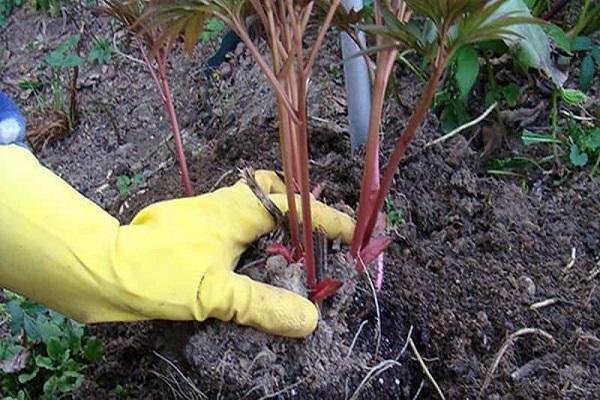
Landing scheme
To plant a peony in open ground, you must first prepare holes up to 70 cm deep and leave for several days.
Then you need to perform the following action:
add fertilizer to the holes;
put drainage, you can use pebbles or chips;
seedlings must be chosen with 2-3 buds;
place in the well and sprinkle gently with the nutrient mixture.
After the hole is filled up, it is necessary to compact the soil and water it with warm water.


